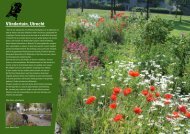Landbouw en landgebruik in internationaal perspectief Voorwoord
Landbouw en landgebruik in internationaal perspectief Voorwoord
Landbouw en landgebruik in internationaal perspectief Voorwoord
Create successful ePaper yourself
Turn your PDF publications into a flip-book with our unique Google optimized e-Paper software.
tools of a Common Agricultural Policy. However, nature conservation strategy <strong>in</strong> a European<br />
context is dep<strong>en</strong>d<strong>en</strong>t on a successful <strong>in</strong>tegration strategy.<br />
Common European rules for agricultural markets are necessary. I share the view that to<br />
achieve the biodiversity targets it is necessary to use market mechanisms such as ecocertification<br />
and paym<strong>en</strong>ts for ecosystem services, thus reward<strong>in</strong>g farmers wh<strong>en</strong> they deliver<br />
b<strong>en</strong>efits for the <strong>en</strong>vironm<strong>en</strong>t, which under market conditions would otherwise not exist. I<br />
agree it is also necessary to reduce subsidies for 'large scale monocultures'. In Europe the<br />
agricultural subsidies are not well targeted, therefore there is a lot of scope for improvem<strong>en</strong>ts<br />
focuss<strong>in</strong>g on what we want to see.<br />
Equally important is the need for public <strong>in</strong>vestm<strong>en</strong>ts <strong>in</strong> what Sara Scherr calls multistakeholder<br />
plann<strong>in</strong>g and action - although we have to be aware that <strong>in</strong>strum<strong>en</strong>ts such as the<br />
LEADER approach and its national equival<strong>en</strong>ts <strong>in</strong> Europe already exist. However we should<br />
also be aware, that the complex topic of <strong>in</strong>tegrated land use managem<strong>en</strong>t needs qualification<br />
and structures. For example <strong>in</strong> Germany we fund NGOs to help them to be successful <strong>in</strong><br />
programme plann<strong>in</strong>g for susta<strong>in</strong>able rural developm<strong>en</strong>t. We also have to ask if structures such<br />
as local action groups are additional complem<strong>en</strong>tary structures (leav<strong>in</strong>g exist<strong>in</strong>g structures<br />
untouched) or whether these will gradually replace other plann<strong>in</strong>g <strong>in</strong>strum<strong>en</strong>ts <strong>in</strong> order to<br />
support susta<strong>in</strong>able rural developm<strong>en</strong>t. I raise these questions because there has be<strong>en</strong><br />
disappo<strong>in</strong>tm<strong>en</strong>t with the exist<strong>in</strong>g European <strong>in</strong>tegration strategy, <strong>in</strong> the light of experi<strong>en</strong>ces <strong>in</strong><br />
rec<strong>en</strong>t years of the national strategies for rural developm<strong>en</strong>t. The question that arises is 'for<br />
whom is it an <strong>in</strong>c<strong>en</strong>tive to <strong>in</strong>tegrate?' Article 6 of the Amsterdam treaty states that<br />
'Environm<strong>en</strong>tal protection requirem<strong>en</strong>ts must be <strong>in</strong>tegrated <strong>in</strong>to the def<strong>in</strong>ition and<br />
implem<strong>en</strong>tation of the community policies <strong>in</strong> particular with a view to promot<strong>in</strong>g susta<strong>in</strong>able<br />
developm<strong>en</strong>t'.<br />
Integration is most important for <strong>en</strong>vironm<strong>en</strong>talists, because the managem<strong>en</strong>t of Natura 2000<br />
areas is dep<strong>en</strong>d<strong>en</strong>t on the exist<strong>in</strong>g EU agricultural and structural funds. But is <strong>in</strong>tegration<br />
important for all farmers and other land users, too? That is why ENCA - the European<br />
Network of Nature Conservation Ag<strong>en</strong>cies - was founded. As ENCA Interest Group<br />
Susta<strong>in</strong>able Land Use and Agriculture we want to develop a strategic view on nature<br />
conservation issues with regard to the reform of the Common Agricultural Policy and the<br />
design of Integrated Rural Developm<strong>en</strong>t policies. We are curr<strong>en</strong>tly work<strong>in</strong>g on a common<br />
vision for CAP and exchang<strong>in</strong>g <strong>in</strong>formation on f<strong>in</strong>ancial demands and effici<strong>en</strong>t agri<strong>en</strong>vironm<strong>en</strong>tal<br />
measures 3 .<br />
1. Presid<strong>en</strong>t of Ecoagriculture Partners, Wash<strong>in</strong>gton DC (www.ecoagriculture.org)<br />
2.The 'ecoagriculture landscape' approach was first described by Jeffrey McNeely and Sara J.<br />
Scherr <strong>in</strong> their 2001 report Common Ground, Common Future: How Ecoagriculture Can Help<br />
Feed the World and Save Wild Biodiversity (Future Harvest and IUCN, Wash<strong>in</strong>gton).<br />
3. For further <strong>in</strong>formation: <strong>en</strong>canet.eu


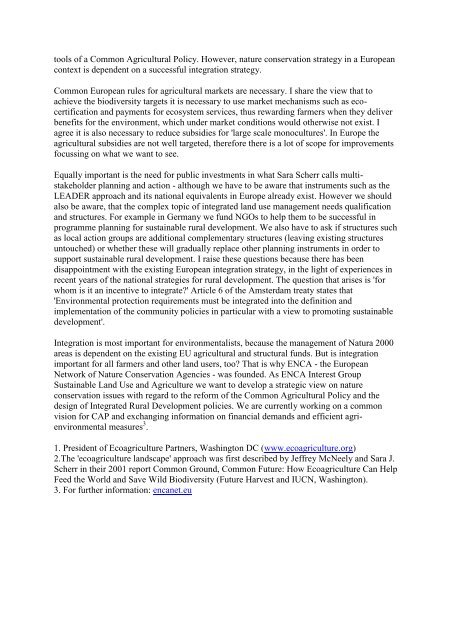
!['Zwaveldioxide en zwaveltrioxide' [pdf] - Raad voor de leefomgeving ...](https://img.yumpu.com/20578080/1/184x260/zwaveldioxide-en-zwaveltrioxide-pdf-raad-voor-de-leefomgeving-.jpg?quality=85)

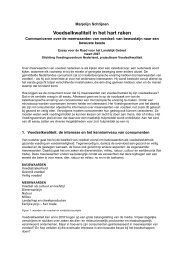
!['Ammoniak als koudemiddel' [pdf] - Raad voor de leefomgeving en ...](https://img.yumpu.com/20336041/1/184x260/ammoniak-als-koudemiddel-pdf-raad-voor-de-leefomgeving-en-.jpg?quality=85)

!['Reacties uit het veld' [pdf]](https://img.yumpu.com/20207000/1/184x260/reacties-uit-het-veld-pdf.jpg?quality=85)
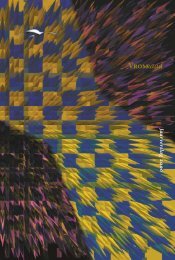
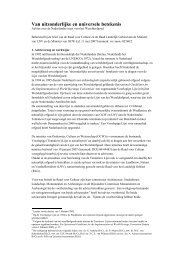
![Download het volledige advies 'Ruimte voor duurzame landbouw' [pdf]](https://img.yumpu.com/19986529/1/188x260/download-het-volledige-advies-ruimte-voor-duurzame-landbouw-pdf.jpg?quality=85)
